 W
WCattle, taurine cattle, Eurasian cattle, or European cattle are large domesticated cloven-hooved herbivores. They are a prominent modern member of the subfamily Bovinae, are the most widespread species of the genus Bos. Depending on sex, they are referred to as cows (female) or bulls (male).
 W
WFeeder cattle, in some countries or regions called store cattle, are young cattle mature enough either to undergo backgrounding or to be fattened in preparation for slaughter. They may be steers or heifers. The term often implicitly reflects an intent to sell to other owners for fattening (finishing). Backgrounding occurs at backgrounding operations, and fattening occurs at a feedlot. Feeder calves are less than 1 year old; feeder yearlings are between 1 and 2 years old. Both types are often produced in a cow-calf operation. After attaining a desirable weight, feeder cattle become finished cattle that are sold to a packer. Packers slaughter the cattle and sell the meat in carcass boxed form.
 W
WBos is the genus of wild and domestic cattle. Bos can be divided into four subgenera: Bos, Bibos, Novibos, and Poephagus, but including these last three divisions within the genus Bos without including Bison in the genus is believed to be paraphyletic by many workers on the classification of the genus since the 1980s. The genus has five extant species. However, this may rise to eight if the domesticated varieties are counted as separate species, and ten if the closely related genus Bison is also included. Most but not all modern breeds of domesticated cattle are believed to have originated from the extinct aurochs. Many ancient breeds are thought to have originated from other species. Zebus and taurine cattle are thought to descend from ancient Indian and Middle Eastern aurochs, respectively.
 W
WThe civilization of ancient Egypt was indebted to the Nile River and its dependable seasonal flooding. The river's predictability and fertile soil allowed the Egyptians to build an empire on the basis of great agricultural wealth. Egyptians are credited as being one of the first groups of people to practice agriculture on a large scale. This was possible because of the ingenuity of the Egyptians as they developed basin irrigation. Their farming practices allowed them to grow staple food crops, especially grains such as wheat and barley, and industrial crops, such as flax and papyrus.
 W
WAqua omnium florum or all-flower water was water distilled from cow-dung in May, when the cows ate fresh grass with meadow flowers. It was also known less euphemistically as aqua stercoris vaccini stillatitia. This was used as a medicine to treat a variety of ailments including gout, rheumatism and tuberculosis.
 W
WAutomatic milking is the milking of dairy animals, especially of dairy cattle, without human labour. Automatic milking systems (AMS), also called voluntary milking systems (VMS), were developed in the late 20th century. They have been commercially available since the early 1990s. The core of such systems that allows complete automation of the milking process is a type of agricultural robot. Automated milking is therefore also called robotic milking. Common systems rely on the use of computers and special herd management software. Also it used to monitor the health status of cows.
 W
WThe Beefsteak Raid was a Confederate cavalry raid that took place in September 1864 as part of the Siege of Petersburg during the American Civil War. Confederate Maj. Gen. Wade Hampton led a force of 3,000 troopers of the Confederate States Army on what was to become a 100-mile (160 km) ride to acquire cattle that were intended for consumption by the Union Army, which was laying a combined siege to the cities of Richmond and Petersburg, Virginia.
 W
WA Boom Boom Ox is a decorated ox used in Tamil Nadu, India for fortune-telling by Boom Boom Mattukaran tribe. These oxen are decorated with jewellery, bells and bright cloth and are led by fortune tellers to individual houses or places where people gather. The patron usually stands in front of the ox and the fortune teller. The fortune teller asks the ox questions in a sing-song voice about the future of the patron. The Ox is trained to nod yes or no for the questions and from its head nods, the fortune teller tells the fortune of the patron. The term "Boom Boom Ox" is also used an insult in Tamil to denote a yes man or a weak willed person.
 W
WThe genome of a female Hereford cow was published in 2009. It was sequenced by the Bovine Genome Sequencing and Analysis Consortium, a team of researchers led by the National Institutes of Health and the U.S. Department of Agriculture. It was part of an effort to improve livestock breeding and at the time was one of the largest genomes ever sequenced.
 W
WA bull is an intact adult male of the species Bos taurus. More muscular and aggressive than the females of the same species, the cows, bulls have long been an important symbol in many cultures, and play a significant role in beef ranching, dairy farming, and a variety of other cultural activities, including bullfighting and bull riding.
 W
WA bullock cart or ox cart is a two-wheeled or four-wheeled vehicle pulled by oxen. It is a means of transportation used since ancient times in many parts of the world. They are still used today where modern vehicles are too expensive or the infrastructure favor them.
 W
WA calf is a young domestic cow or bull. Calves are reared to become adult cattle or are slaughtered for their meat, called veal, and hide.
 W
WA cannulated cow or "fistulated cow" refers to a cow that has been surgically fitted with a cannula. A cannula acts as a porthole-like device that allows access to the rumen of a cow, to perform research and analysis of the digestive system and to allow veterinarians to transplant rumen contents from one cow to another.
 W
WThe age of cattle is determined chiefly by examination of the teeth, and less perfectly by the horn rings or the length of the tail brush; however due to bang-tailing, which is the act of cutting the long hairs at the tip of the tail short to identify the animal after management practices, the latter is least reliable.
 W
WA cattle chute or cattle race also called a run or alley, is a narrow corridor built for cattle and other animals to travel through when being herded from one location to another that is nearby. A conventional race consists of parallel panels or fences with a space between them just wide enough for one animal to pass through comfortably without being able to turn around, thus forming the animals into a queue that only allows them to go forward. It is used for routine husbandry activities such as drafting (sorting) or loading animals via ramp or loading chute into a vehicle; placing them one at a time in a cattle crush (variations also called a squeeze chute or standing stock) for examination, marking or veterinary treatment. They are also used at packing plants to move animals into a crush designed for slaughter.
 W
WThere are different systems of feeding cattle in animal husbandry. For pastured animals, grass is usually the forage that composes the majority of their diet. Cattle reared in feedlots are fed hay supplemented with grain, soy and other ingredients to increase the energy density of the feed. The debate is whether cattle should be raised on fodder primarily composed of grass or a concentrate. The issue is complicated by the political interests and confusion between labels such as "free range", "organic", or "natural". Cattle raised on a primarily foraged diet are termed grass-fed or pasture-raised; for example meat or milk may be called grass-fed beef or pasture-raised dairy. The term "pasture-raised" can lead to confusion with the term "free range", which does not describe exactly what the animals eat.
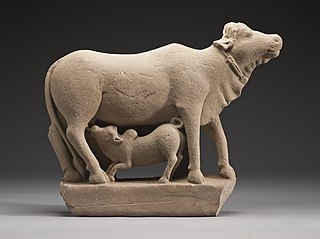 W
WDue to the multiple benefits from cattle, there are varying beliefs about cattle in societies and religions. In some regions, especially most states of India, the slaughter of cattle is prohibited and their meat may be taboo.
 W
WCattle judging is the process of judging a series of cattle and pronouncing a first-, second- and third-place animal based on each animal's individual traits compared to that of the others. Most cattle judging occurs in show rings at agricultural shows and livestock shows.
 W
WA cattle prod, also called a stock prod or a hot stick, is a handheld device commonly used to make cattle or other livestock move by striking or poking them. An electric cattle prod is a stick with electrodes on the end which is used to make cattle move through a relatively high-voltage, low-current electric shock. The electric cattle prod is said to have been invented by Texas cattle baron Robert J. Kleberg, Jr. of the King Ranch around 1930, although versions were sold as early as 1917.
 W
WCattle raiding is the act of stealing cattle. In Australia, such stealing is often referred to as duffing, and the perpetrator as a duffer. In North America, especially in the Wild West cowboy culture, cattle theft is dubbed rustling, while an individual who engages in it is a rustler.
 W
WUrine patches in cattle pastures generate large concentrations of the greenhouse gas nitrous oxide through nitrification and denitrification processes in urine-contaminated soils. Over the past few decades, the cattle population has increased more rapidly than the human population. Between the years 2000 and 2050, the cattle population is expected to increase from 1.5 billion to 2.6 billion. When large populations of cattle are packed into pastures, excessive amounts of urine soak into soils. This increases the rate at which nitrification and denitrification occur and produce nitrous oxide. Currently, nitrous oxide is one of the single most important ozone-depleting emissions and is expected to remain the largest throughout the 21st century.
 W
WChannel Island cattle is a collective name for the breeds of cattle developed in the Channel Islands located between England and France. The breeds which can be so described are the Jersey, the Guernsey and the Alderney.
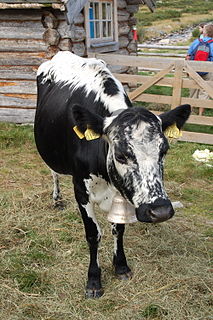 W
WColour-sided is a colour pattern of domesticated cattle. It is sometimes called lineback
 W
WCow blowing, Kuhblasen, phooka, or doom dev, is a process used in many countries according to ethnographers, in which forceful blowing of air into a cow's vagina is applied to induce her to produce more milk.
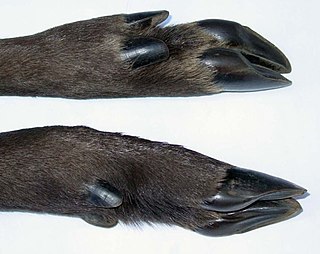 W
WA hoof, plural hooves or hoofs, is the tip of a toe of an ungulate mammal, strengthened by a thick and horny keratin covering.
 W
WCow tipping is the purported activity of sneaking up on any unsuspecting or sleeping upright cow and pushing it over for entertainment. The practice of cow tipping is generally considered an urban legend, and stories of such feats viewed as tall tales. The implication that rural citizens seek such entertainment due to lack of alternatives is viewed as a stereotype. The concept of cow tipping apparently developed in the 1970s, though tales of animals that cannot rise if they fall has historical antecedents dating to the Roman Empire.
 W
WA cow calf operation is a method of raising beef cattle in which a permanent herd of cows is kept by a farmer or rancher to produce calves for later sale. Cow–calf operations are one of the key aspects of the beef industry in the United States and many other countries. In the British Isles, a cow–calf operation may be known as a single-suckler herd. The goal of a cow–calf operation is to produce young beef cattle, which are usually sold. A rancher who works within such a model is often called a "cow–calf operator" in the United States.
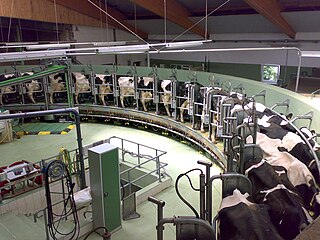 W
WDairy farming is a class of agriculture for long-term production of milk, which is processed for eventual sale of a dairy product.
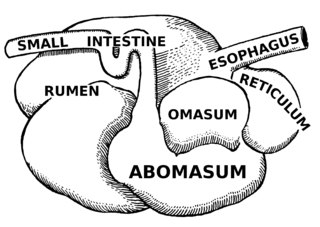 W
WDisplaced abomasum in cattle occurs when the abomasum, also known as the true stomach, which typically resides on the floor of the abdomen, fills with gas and rises to the top of the abdomen, where it is said to be ‘displaced’. When the abomasum moves from its normal position it prevents the natural passage of gas and feed through the digestive system, creating a restriction. As cattle are ruminants, which have a 4 chambered stomach composed of a rumen, reticulum, omasum and abomasum. Ruminants require this specialized digestive system in order to properly process and break down their high fiber and cellulose rich diets. As this type of digestive system is quite complex it is at a greater risk for incidence. Due to the natural anatomy of cattle it is more common to have the abomasum displace to the left, known as a left-displaced abomasum, than to the right, right-displaced abomasum. When the abomasum becomes displaced there also becomes a chance of an abomasal volvulus, twist, developing. An abomasal volvulus occurs when the abomasum, which is already out of place, will rotate and cut off blood and nutrient supply to the abomasum. Cattle which develop an abomasal twist require immediate vet attention to regain blood supply and food passage through the digestive system or the abomasum will begin to shut down due to lack of blood supply and toxicity development.
 W
WA cattle drive is the process of moving a herd of cattle from one place to another, usually moved and herded by cowboys on horses.
 W
WFinching is a colour pattern of cattle occurring in many unrelated breeds. Cattle with finching are said to be finched or finch-backed.
 W
WFutureFeed is a seaweed-based feed ingredient for livestock that is currently being developed by a dedicated team from Australia's Commonwealth Scientific and Industrial Research Organisation (CSIRO). The primary component of FutureFeed is dried Asparagopsis, a genus of red algae, which has been shown to reduce the methane (CH4) emissions of ruminant livestock by up to 99%. It is added to fodder at feedlots in dosages of 1-2% dietary intake to achieve this result. FutureFeed is currently being developed in collaboration with James Cook University (JCU) and Meat and Livestock Australia (MLA), with the primary goal of scaling for mainstream commercial use.
 W
WHaven Herefords is the oldest family run herd of Hereford cattle in the world and is operated from the hamlet known as The Haven at Dilwyn in Herefordshire, UK. The herd is in its fifth generation and is currently being run by Edward Lewis.
 W
WCattle, taurine cattle, Eurasian cattle, or European cattle are large domesticated cloven-hooved herbivores. They are a prominent modern member of the subfamily Bovinae, are the most widespread species of the genus Bos. Depending on sex, they are referred to as cows (female) or bulls (male).
 W
WLacticaseibacillus casei is a species of genus Lacticaseibacillus. This particular species of Lacticaseibacillus is documented to have a wide pH and temperature range, and complements the growth of L. acidophilus, a producer of the enzyme amylase.
 W
WLivestock branding is a technique for marking livestock so as to identify the owner. Originally, livestock branding only referred to hot branding large stock with a branding iron, though the term now includes alternative techniques. Other forms of livestock identification include freeze branding, inner lip or ear tattoos, earmarking, ear tagging, and radio-frequency identification (RFID), which is tagging with a microchip implant. The semi-permanent paint markings used to identify sheep are called a paint or color brand. In the American West, branding evolved into a complex marking system still in use today.
 W
WA cattle crush, squeeze chute, cattle chute, standing stock, or simply stock is a strongly built stall or cage for holding cattle, horses, or other livestock safely while they are examined, marked, or given veterinary treatment. Cows may be made to suckle calves in a crush. For the safety of the animal and the people attending it, a close-fitting crush may be used to ensure the animal stands "stock still". The overall purpose of a crush is to hold an animal still to minimise the risk of injury to both the animal and the operator while work on the animal is performed.
 W
WDehorning is the process of removing the horns of livestock. Cattle, sheep, and goats are sometimes dehorned for economic and safety reasons. Disbudding is a different process with similar results; it cauterizes and thus destroys horn buds before they have grown into horns. Disbudding is commonly performed early in an animal's life, as are other procedures such as docking and castration.
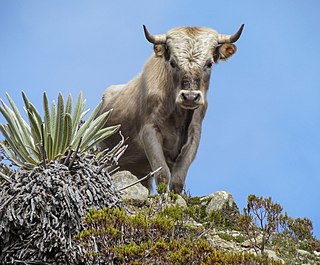 W
WA maverick is an animal, usually a form of cattle, that does not carry a brand. It is a word also used to describe a person who acts free from constrains or from organizational guidelines.
 W
WA mixer-wagon, or diet feeder, is a specialist agricultural machine used for accurately weighing, mixing and distributing total mixed ration (TMR) for ruminant farm animals, in particular cattle and most commonly, dairy cattle.
 W
WA nose ring is a ring made of metal designed to be installed through the nasal septum of pigs as well as domestic cattle, usually bulls. In pigs, nose rings are alternatively installed through the rim of the nose. Nose rings are often required for bulls when exhibited at agricultural shows. There is a clip-on ring design used for controlling and directing cattle for handling. Nose rings are used to encourage the weaning of young calves by discouraging them from suckling.
 W
WIn the Western United States and Canada, open range is rangeland where cattle roam freely regardless of land ownership. Where there are "open range" laws, those wanting to keep animals off their property must erect a fence to keep animals out; this applies to public roads as well. Land in open range that is designated as part of a "herd district" reverses liabilities, requiring an animal's owner to fence it in or otherwise keep it on the person's own property. Most eastern states and jurisdictions in Canada require owners to fence in or herd their livestock.
 W
WAn ox, also known as a bullock, is a male bovine trained and used as a draft animal. Oxen are commonly castrated adult male cattle; castration inhibits testosterone and aggression, which makes the males docile and safer to work with. Cows or bulls may also be used in some areas.
 W
WAn ox-wagon or bullock wagon is a four-wheeled vehicle pulled by oxen. It was a traditional form of transport, especially in Southern Africa but also in New Zealand and Australia. Ox-wagons were also used in the United States. The first recorded use of an ox-wagon was around 1670, but they continue to be used in some areas up to modern times.
 W
WPanda cow is a breed of miniature cattle with markings that resemble those of a giant panda. There are reportedly only 24 in the world, as of January 2011.
 W
WRoan is a coat color found in many animals, including horses, cattle, antelope, cat and dogs. It is defined generally as an even mixture of white and pigmented hairs that do not "gray out" or fade as the animal ages. There are a variety of genetic conditions which produce the colors described as "roan" in various species.
 W
WSanga cattle is the collective name for indigenous cattle of sub-Saharan Africa. They are sometimes identified as a subspecies with the scientific name Bos taurus africanus. These cattle originated in East Africa, probably the western shores of Lake Victoria, and have spread down the river Nile, with depictions on Ancient Egyptian murals. Sanga are an intermediate type, probably formed by hybridizing the indigenous humpless cattle with Zebu cattle. However, archaeological evidence indicates this cattle type was domesticated independently in Africa, and bloodlines of taurine and zebu cattle were introduced only within the last few hundred years. The timeline for their history is the subject of extensive debate. A combination of genetic studies with archaeological research, including cultural history, has clarified the question of the complex origin of African cattle in recent years. Thus African cattle descend firstly from an aurochs domesticated in the Near East. After their introduction to Egypt, about eight thousand years ago, they spread all over the Sahara which was then still green, up to West Africa. The north African pastoralists interbred their domestic cattle with wild African Aurochs of various regional races, both in the paternal and maternal lines over a long time, which is reflected in the genetic distinctness of African cattle from both European / near Eastern and from Indian Zebu cattle. Hereby special adaptations to the African climate and conditions were introduced, that characterise African cattle - both those deriving solely from Aurochs and the Sanga cattle with their Zebu admixture. Morphological features of early African cattle, such as lyre-shaped horns, are depicted on murals of Ancient Egypt. Some authors date the first Sanga cattle, which originated through by crossing in of Zebu bulls in northeast and east Africa, from 1600 BC on. They are distinguished by having small cervicothoracic humps, that are typical for (wild) Aurochs, instead of the high thoracic humps which characterize the Zebu.
 W
WA somatic cell count (SCC) is a cell count of somatic cells in a fluid specimen, usually milk. In dairying, the SCC is an indicator of the quality of milk—specifically, its low likeliness to contain harmful bacteria, and thus its high food safety. White blood cells (leukocytes) constitute the majority of somatic cells in question. The number of somatic cells increases in response to pathogenic bacteria like Staphylococcus aureus, a cause of mastitis. The SCC is quantified as cells per milliliter. General agreement rests on a reference range of less than 100,000 cells/mL for uninfected cows and greater than 250,000 for cows infected with significant pathogen levels. Several tests like the PortaSCC milk test and The California mastitis test provide a cow-side measure of somatic cell count. The somatic cell count in the milk also increases after calving when colostrum is produced.
 W
WStock theft in Namibia is a prevalent crime. Animals are slaughtered for human consumption or sold at auctions for money gain.
 W
WTaurine cattle, also called European cattle, are a subspecies of domesticated cattle originating in the Near East. Both taurine cattle and indicine cattle (zebus) are descended from the aurochs. Taurine cattle were originally considered a distinct species, but are now typically grouped with zebus and aurochs into one species, Bos taurus. Most modern breeds of cattle are taurine cattle.
 W
WTōgyū (闘牛) also known as ushi-zumo or Bull sumo, is a spectator sport native to the Ryukyu Islands of Japan. It is also held in other regions of Japan, such as Iwate Prefecture, Niigata Prefecture, Shimane Prefecture, and Ehime Prefecture. Although sometimes known to Westerners as "Okinawan bullfighting", it is drastically different from the Spanish or Portuguese style of bullfighting where the matches are between a bull and a human, with blood being spilt. Tōgyū has more in common with northern Portugal's sport of chegas and the Swiss sport of cow fighting.
 W
WTotal mixed ration (TMR) is a method of feeding dairy cattle. The purpose of feeding a TMR diet is that each cow can consume the required level of nutrients in each bite. A cow's ration should include good quality forages, a balance of grains and proteins, vitamins and minerals.